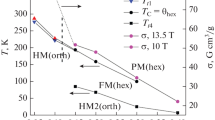Abstract
Reverse first-order magnetostructural phase transitions have been theoretically analyzed within the model of interacting parameters of magnetic and structural orders. A characteristic feature of these transitions is stepwise occurrence of the magnetic order upon cooling (as in the case of the first-order phase transition) and its smooth disappearance upon heating (as in the conventional second-order phase transition). These transitions are observed in some alloys of the Mn1 – xCrxNiGe magnetocaloric systems under pressure (x = 0.11) and without it (x = 0.18) and are accompanied by specific magnetic and magnetocaloric features. These specific features are phenomenologically described within the concept of soft mode for a structural subsystem undergoing the first-order structural phase transition (P63/mmc–Pnma) and the Heisenberg model for a spin subsystem. It is shown for systems with magnetostructural instability within the molecular-field approximation for a spin subsystem and the approximation of biased harmonic oscillator for a lattice subsystem that reverse phase transitions occur when the magnetic disordering temperature is in the range of temperature hysteresis of the P63/mmc–Pnma first-order structural phase transition. It is also shown that the two-peak form of isothermal entropy (characteristic of reverse transitions) is due to separation of contributions from the structural and magnetic entropies.







Similar content being viewed by others
REFERENCES
V. I. Val’kov, V. I. Kamenev, V. I. Mityuk, I. F. Gribanov, A. V. Golovchan, and T. Yu. Delikatnaya, Phys. Solid State 59, 274 (2017).
V. I. Val’kov, I. F. Gribanov, B. M. Todris, A. V. Go-lovchan, and V. I. Mityuk, Phys. Solid State 60, 1125 (2018).
V. I. Val’kov, A. V. Golovchan, V. V. Koledov, B. M. Todris, and V. I. Mityuk, Phys. Solid State 62, 798 (2020).
B. Penc, A. Hoser, S. Baran, and A. Szytuła, Phase Trans. 91, 118 (2018).
J. Łažewski, P. Piekarz, and K. Parlinski, Phys. Rev. B 83, 054108 (2011).
R. Blinc and B. Žekš, Soft Modes in Ferroelectrics and Antiferroelectrics (North-Holland, Amsterdam, 1974).
A. I. Liechtenstein, M. I. Katsnelson, V. P. Antropov, and V. A. Gubanov, J. Magn. Magn. Mater. 67, 65 (1987).
I. Rungger and S. Sanvito, Phys. Rev. B 74, 024429 (2006).
L. M. Sandratskii and E. Sasioglu, Phys. Rev. B 74, 214422 (2006).
Funding
This study was supported by the Russian Science Foundation (project no. 20-19-00745).
Author information
Authors and Affiliations
Corresponding author
Ethics declarations
The authors declare that they have no conflicts of interest.
Additional information
Translated by A. Sin’kov
APPENDIX
APPENDIX
The Hamiltonian of a spin subsystem in the presence of external magnetic field H0 can be written as
where \({\mathbf{\hat {s}}}_{n}^{k}\) is the spin operator of atom k in hexagonal unit cell n; \({\mathbf{J}}_{{nn'}}^{{kk'}}\) ≡ \(J(\left| {\Delta {\mathbf{R}}_{{nn'}}^{{kk'}}} \right|)\) are the corresponding integrals of exchange interaction between magnetoactive atoms at distances \(\left| {\Delta {\mathbf{R}}_{{nn'}}^{{kk'}}} \right|\); \(\sum\nolimits_n {{{N}_{0}}} \) and \(\sum\nolimits_{n,k} \) = N = 2N0(1 – x) are the number of unit cells and the number of magnetic active atoms (Mn) per unit volume; H0 = (0, 0, H0) is the vector of external uniform magnetic field; and μ0 is the Bohr magneton.
For a simple helimagnetic (HM) with the wave vector k = (0, 0, ka), angle \(\Psi _{{nn'}}^{{kk'}}\) between the directions of spin means of atoms spaced by distances \(\left| {\Delta {\mathbf{R}}_{{nn'}}^{{kk'}}} \right|\) is determined by the expression \(\Psi _{{nn'}}^{{kk'}}\) = \({\mathbf{k}}({\mathbf{R}}_{{n'}}^{{k'}}\) – \({\mathbf{R}}_{n}^{k})\) ≡ \({\mathbf{k}}\Delta {\mathbf{R}}_{{nn'}}^{{kk'}}\) = \({{k}_{a}}c_{{nn}}^{{kk'}}\) (\(c_{{nn}}^{{kk'}}\) is the distance between atoms kn and k'n' along the wave vector k). To describe HM ordering within the mean-field approximation, we use Hamiltonian (A.2), in which the direction of the spatially inhomogeneous mean field \({\mathbf{h}}_{n}^{k}\) = \(h{\mathbf{U}}_{n}^{k}\) for atom at the site \({\mathbf{R}}_{n}^{k}\) is determined by the unit vector \({\mathbf{U}}_{n}^{k}\) = (cos(\({\mathbf{kR}}_{n}^{k}\)))sin(ϑ)sin(\({\mathbf{kR}}_{n}^{k}\))sin(ϑ), cos(ϑ)) and coincides with the direction of the local quantization axis. It is assumed that the local quantization axis at H0 = 0 lies in the basal plane oriented perpendicular to k (ϑ = π/2). The model Hamiltonian \({{{\mathbf{\hat {H}}}}_{{hs}}}\) and the model free energy Ωh ≡ Ω(h) are determined by the expressions
where \(\hat {m}_{n}^{k}\) = \({\mathbf{U}}_{n}^{k}{\mathbf{\hat {s}}}_{n}^{k}\) is the operator of spin projection on the quantization axis and
It is taken into account in (A.4a) that \({{{\mathbf{H}}}_{0}}{\mathbf{U}}_{n}^{k}\) = \({{H}_{0}}\cos (\vartheta )\) and only components \(\hat {m}_{n}^{k}\) directed along the mean field contribute to the diagonal eigenvalues \({\mathbf{\hat {s}}}_{n}^{k}\); therefore, the relation between the mean values of spin \({{\left\langle {{\mathbf{\hat {s}}}_{n}^{k}} \right\rangle }_{h}}\) and \({{\left\langle {\hat {m}_{n}^{k}} \right\rangle }_{h}}\) within the mean-field approximation is determined by the expression
Averaging within the mean-field approximation is performed according to the scheme
Within the approximation of nearest and next Mn atoms in the plane oriented perpendicular to the wave vector k, J(ka) has the form
Taking into account (A.4–A.6), Ωh can be written in the form
The expression for the mean-field magnitude h is determined from the condition dΩh/dh = \(\partial {{\Omega }_{h}}{\text{/}}\partial h\) + \((\partial {{\Omega }_{h}}{\text{/}}\partial y)dy{\text{/}}dh\) = 0, which, with allowance for (A.5), is reduced to the form
Hence,
After substituting the expression for h into (A.7), Ωh ≡ Ω(h) takes the form of Ω2(y) in (3c).
Rights and permissions
About this article
Cite this article
Val’kov, V.I., Kamenev, V.I., Golovchan, A.V. et al. Magnetic and Magnetocaloric Effects in Systems with Reverse First-Order Transitions. Phys. Solid State 63, 1889–1899 (2021). https://doi.org/10.1134/S1063783421050188
Received:
Revised:
Accepted:
Published:
Issue Date:
DOI: https://doi.org/10.1134/S1063783421050188




